Biking My Way Around Philadelphia
by Odochi Akwani, Writer and Content Manager
June 30, 2025
Stories from a writer’s personal experience riding around their city.
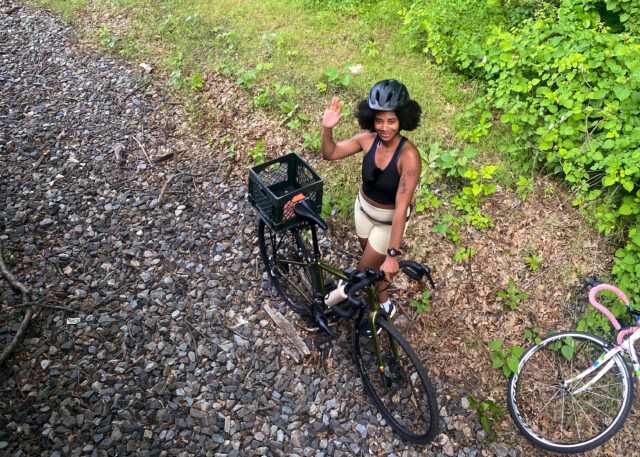
In Philadelphia, day to day, I can easily get around on foot to where I need to go as someone who works from home and lives close to my essential destinations. That wasn’t the case when I first arrived in the city back in 2022, when I was commuting 45 minutes or more by bus to an office in Southwest Philadelphia.
The bus I needed to take and then transfer to a trolley wasn’t (and still isn’t) very reliable. I learned to adjust and take an earlier bus to avoid being late, or sometimes ride my bike last minute. Biking wasn’t an option I felt super comfortable with during rush hour due to the lack of protected bike lanes along Washington Avenue, especially as you get to Grays Ferry Avenue, which is a higher-speed road. The busy intersection of 34th Street and Grays Ferry Avenue has a red light camera that issued 17,227 citations in 2024, which is ranked fourth in the city for most citations last year.
This year, Grays Ferry Avenue completed a protected bikeway on a newly repaved road, making biking much more comfortable than before. According to Vision Zero PHL, “On Grays Ferry Avenue between 2016 and 2020, there were 44 reported crashes. Of those involved, 11 were cyclists, and 3 were pedestrians.”
This spring, I biked much more throughout May and early June. These current 100-degree days make me miss the 60-70 degree weather that was perfect for riding around the city.
I spent several Sundays biking along the Schuylkill River Trail, a popular trail for bikers, runners, and walkers alike. Conveniently, I live near the Pine and Spruce Street bike lanes, so I’m able to hop on and ride straight west to meet the trail. Currently, these bike lanes are undergoing bike lane safety upgrades through a Complete Streets project.
Last July, Dr. Barbara Friedes was killed by a drunk driver as she was biking west on the Spruce Street bike lane after the driver went left around a stopped car, cutting through the bike lane and flex posts. This tragedy caused bike and street safety activists to advocate for more protections on these unprotected bike lanes.
Through this safety upgrade project, the city just this month implemented loading zones along these streets so thatcars, moving trucks, delivery trucks, mail delivery vehicles, etc. have a designated spot to unload instead of parking in the bike lane or idling in the one lane road causing impatient drivers to cut into the bike lane. Additionally, the city’s “Get Out the Bike Lane” bill, which prohibits stopping, standing, or parking in bike lanes and increases the associated fines, began formal enforcement on June 19.
“We’re starting on Pine and Spruce Streets, but looking to analyze where we have curbside bike lanes that need signs upgraded,” says Kelley Yemen, director at the City of Philadelphia Office of Multimodal Planning. “Places like Third Street, where we’re putting in new bike lanes. Those are starting as no standing or no stopping at any time. Then we’re adding loading zones so that people have places to load and they get out of the bike lane.”
After biking west on Spruce Street, I meet the trail and begin biking north. Sundays are typically quite busy, and I often weave around people as I move away from the congested part of the trail, which is closer to the Schuylkill River Park and the Philadelphia Museum of Art. Before, you could connect from the art museum to the Martin Luther King Jr. Drive, which from April to November is closed every weekend to cars. Now you must continue a few more miles north to connect to the open streets while the bridge undergoes construction.
The Martin Luther King, Jr. Drive Bridge rehabilitation project started in March 2023. Construction was expected to finish this spring, but is now projected to be completed by September. The new bridge will include a side path for pedestrians and cyclists among other safety improvements.
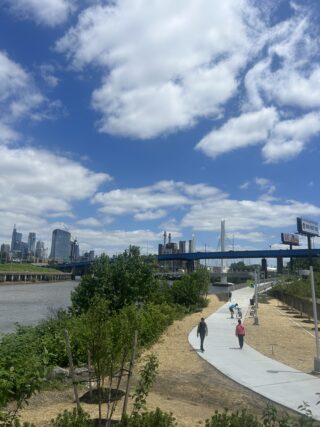
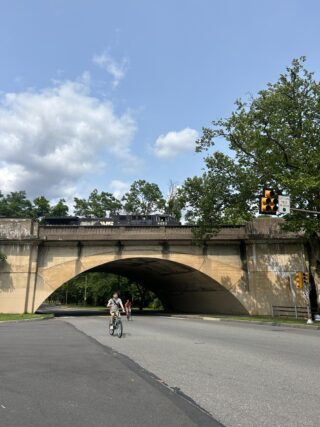
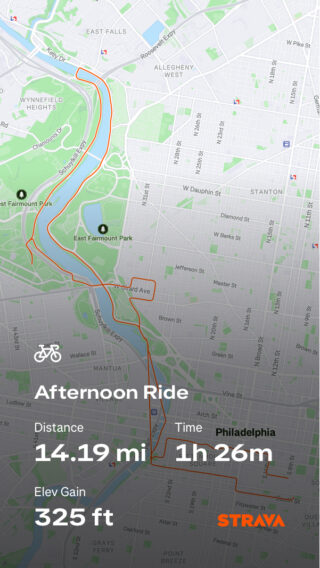
This spring, I also checked out a couple of the newest stations of Philadelphia’s bike share system, Indego. This year, Indego aims to add approximately 40 new stations and 400 Indego electric bikes to its system while focusing on seven neighborhoods as part of its 2025 expansion plan. Indego has added about 20 new stations since the top of the year. I picked up a bike from a new station at 26th and Moore outside of Vare Recreation Center, a community space offering both youth and young adult activities.
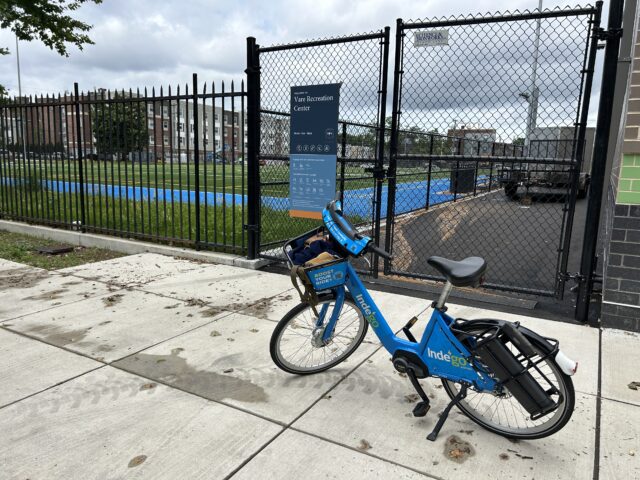
Afterward, I made my way to the new 51st and Regent station outside of the Kingsessing Library station. Kingsessing is home to a vibrant African immigrant community. It’s also one of the seven focus areas for Indego’s expansion. Just a few months ago, legislation was introduced to move forward with the 47th Street Repaving & Traffic Safety Project to improve traffic safety for all users, including installing a parking-separated bike lane between Kingsessing Avenue and Chestnut Street. Click here to view a conceptual diagram of the project.
The journey there was a bit more challenging. I encountered stretches of roads in the process of repavement which made it uncomfortable to bike on. I’ll admit that I resorted to some sidewalk biking due to that and to avoid biking on a three-lane road at a higher speed with no bike lane. The Kingsessing Library is more than just a building of books; it’s part of the Kingsessing Recreation Center and, like the Vare Center, features a playground, pool, sports fields, basketball, and tennis courts along with gyms, an auditorium, and more community gathering spaces. It’s wonderful to see stations near these free third spaces that people of all ages can utilize.
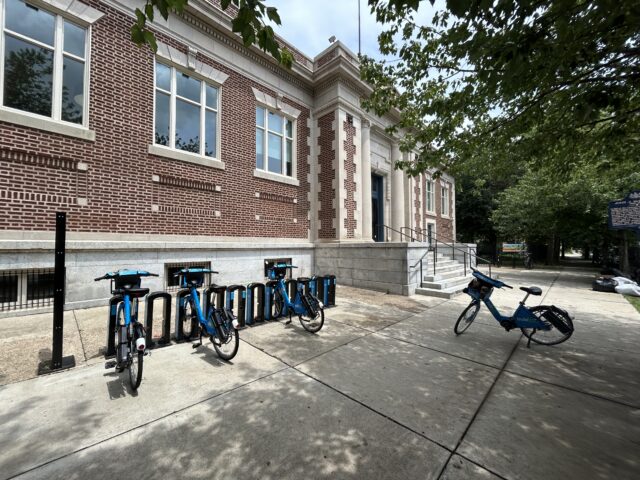
Making my way further west, toward my final station stop, on Cobbs Creek and Florence Streets, I notice fewer bikers on the road, if any, as well as painted bike lanes becoming more and more faded. Although fading, I was surprised by the number of painted bike lanes on many of the major connector roadways. West Philadelphia tends to be hillier in general, so the e-assist on the bike helped get up some serious hills.
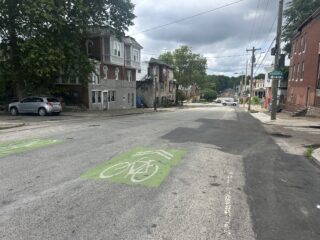
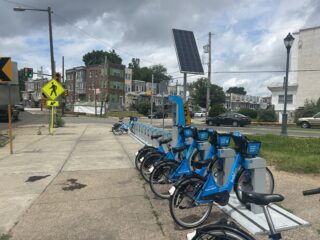
The journey home took me across the Walnut Street Bridge, which meant a firsthand look at the Market Street Bridges Rehabilitation and Improvement Project. As part of this project, a “temporary” two-way bicycle lane with concrete parking separators was installed with a bicycle signal.
This past year of writing for BBSP, I’ve realized how essential shared mobility is as an option in the transportation landscape of cities of all sizes. By speaking with different systems and riders, I’ve learned that community awareness and engagement are crucial for the success of shared micromobility as it continues to expand. More progress is needed in areas like street design, funding allocation, and education. But, with Complete Streets initiatives creating protected bike lanes and safer streets for everyone, and as Indego expands into its focus areas, Philadelphia is becoming a more equitable city for everyone to move around.
________________________________________________________________________________________
The Better Bike Share Partnership is funded by The JPB Foundation as a collaboration between the City of Philadelphia, the National Association of City Transportation Officials (NACTO), and the PeopleForBikes Foundation to build equitable and replicable bike share systems. Follow us on LinkedIn, Facebook, Twitter, and Instagram, or sign up for our weekly newsletter.
Have a question or a story idea? Email odochi@peopleforbikes.org.
